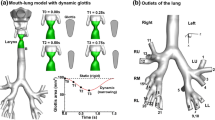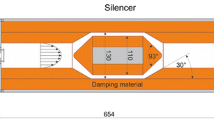Abstract
Physical modelling of phonation requires a mechanical description of the vocal fold coupled to a description of the flow within the glottis. In this study, an in-vitro set-up, allowing to reproduce flow conditions comparable to those of human glottal flow is used to systematically verify and discuss the relevance of the pressure and flow-rate predictions of several laminar flow models. The obtained results show that all the considered flow models underestimate the measured flow-rates and that flow-rates predicted with the one-dimensional model are most accurate. On the contrary, flow models based on boundary-layer theory and on the two-dimensional numerical resolution of Navier–Stokes equations yield most accurate pressure predictions. The influence of flow separation on the predictions is discussed since these two models can estimate relevant flow separation positions whereas this phenomenon is treated in a simplified ad-hoc way in the one-dimensional flow modelling. Laminar flow models appear to be unsuitable to describe the flow downstream of the glottal constriction. Therefore, the use of flow models taking into account three-dimensional effects as well as turbulence is motivated.






Similar content being viewed by others
References
ADINA (2006) Theory and modeling guide, vol III: ADINA CFD & FSI. ADINA R&D, Inc., Watertown
Alipour F, Titze IR (1996) Combined simulations of two-dimensional airflow and vocal fold vibration. In: Davis PJ, Fletcher NH (eds) Vocal fold physiology: controlling complexity and Chaos. Singular Publishing Group, San Diego, pp 17–29
Cisonni J, Van Hirtum A, Pelorson X, Willems J (2008) Theoretical simulation and experimental validation of inverse quasi one-dimensional steady and unsteady glottal flow models. J Acoust Soc Am 124(1):535–545
de Oliveira Rosa M, Pereira J (2007) Aerodynamic study of three-dimensional larynx models using finite element methods. J Sound and Vib 311:39–55
de Vries M, Schutte H, Verkerke G (1999) Determination of parameters for lumped parameter models of the vocal folds using a finite-element method approach. J Acoust Soc Am 106(6):3620–3628
de Vries M, Schutte H, Veldman A, Verkerke G (2002) Glottal flow through a two-mass model: comparison of Navier-Stokes solutions with simplified models. J Acoust Soc Am 111(4):1847–1853
Decker G, Thomson S (2007) Computational simulations of vocal fold vibration: Bernoulli versus Navier-Stokes. J Voice 21:273–284
Deverge M, Pelorson X, Vilain C, Lagree P, Chentouf F, Willems J, Hirschberg A (2003) Influence of collision on the flow through in-vitro rigid models of the vocal folds. J Acoust Soc Am 114(6):1–9
Hirano M, Kurita S, Nakashima T (1983) Growth, development and aging of human vocal folds. In: Bless D, Abbs J (eds) Vocal fold physiology. College Hill Press, San Diego, pp 22–43
Horacek J, Svec J (2002) Aeroelastic model of vocal-fold-shaped vibrating element for studying the phonation threshold. J Fluids Struct 16(7):931–955
Ishizaka K, Flanagan J (1972) Synthesis of voiced sounds from a two-mass model of the vocal cords. Bell Syst Tech J 51:1233–1267
Kacha A, Bettens F, Grenez F (2006) Vocal dysperiodicities estimation by means of adaptive long-term prediction. Med Biol Eng Comput 44:61–68
Lagrée P, Lorthois S (2005) The RNS/Prandtl equations and their link with other asymptotic descriptions. Application to the computation of the maximum value of the wall shear stress in a pipe. Int J Eng Sci 43:352–378
Lous N, Hofmans G, Veldhuis N, Hirschberg A (1998) A symmetrical two-mass vocal-fold model coupled to vocal tract and trachea, with application to prosthesis design. Acta Acustica 84:1135–1150
Luo X, Pedley T (2000) Flow limitation and multiple solutions in 2-D collapsible channel flow. J Fluid Mech 420:301–324
Luo X, Calderhead B, Liu H, Li W (2007) On the initial configurations of collapsible tube flow. Comput Struct 85(2):977–987
Mitev P, Hadjitodorov S (2000) A method for turbulent noise estimation in voiced signals. Med Biol Eng Comput 38:625–631
Pelorson X, Hirschberg A, Van Hasselt R, Wijnands A, Auregan Y (1994) Theoretical and experimental study of quasisteady-flow separation within the glottis during phonation. Application to a modified two-mass model. J Acoust Soc Am 96(6):3416–3431
Pelorson X, Liljencrants J, Kroeger B (1995) On the aero-acoustics of voiced sound production. In: Proceedings 15th international conference on acoustics. Trondheim, Norway
Ruty N, Pelorson X, Van Hirtum A, Lopez I, Hirschberg A (2007) An in-vitro setup to test the relevance and the accuracy of low-order vocal folds models. J Acoust Soc Am 121(1), 479–490
Schlichting H, Gersten K (2000) Boundary layer theory. Springer Verlag, Berlin
Thomson S, Mongeau L, Frankel S (2005) Aerodynamic transfer of energy to the vocal folds. J Acoust Soc Am 118(3):1689–1700
Thomson SL, Mongeau L, Frankel SH (2007) Flow over a membrane-covered, fluid-filled cavity. Comput Struct 85:1012–1019
Titze IR (1994) Principles of voice production. Prentice-Hall, Inc, Englewood Cliffs
Titze IR (2002) Regulating glottal airflow in phonation: application of the maximum power transfer theorem to a low dimensional phonation model. J Acoust Soc Am 111:367–376
Van Hirtum A, Pelorson X, Lagrée PY (2005) In vitro validation of some flow assumptions for the prediction of the pressure distribution during obstructive sleep apnoea. Med Biol Eng Comput 43:162–171
Vilain C, Pelorson X, Fraysse C, Deverge M, Hirschberg A, Willems J (2004) Experimental validation of a quasi-steady theory for the flow through the glottis. J Sound Vib 276(3–5):475–490
White F (1982) Viscous fluid flow. McGraw-Hill Book Company, New York
Acknowledgements
This study has been supported by Ph.D. grant from the French Ministry of Education and Research, Explora’Doc scholarship from Rhône-Alpes regional council (France), grant EGIDE Alliance 18224YD and grant ANR-07-JCJC-0055.
Author information
Authors and Affiliations
Corresponding author
Rights and permissions
About this article
Cite this article
Cisonni, J., Van Hirtum, A., Luo, X.Y. et al. Experimental validation of quasi-one-dimensional and two-dimensional steady glottal flow models. Med Biol Eng Comput 48, 903–910 (2010). https://doi.org/10.1007/s11517-010-0645-7
Received:
Accepted:
Published:
Issue Date:
DOI: https://doi.org/10.1007/s11517-010-0645-7




